Flag of New Zealand
 |
|
| Use | National flag and state ensign. |
| Proportion | 1:2 |
| Adopted | 24 March 1902 In use since 1869 |
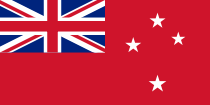 |
|
| Use | Civil ensign. |
| Proportion | 1:2 |
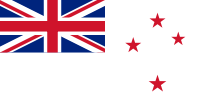 |
|
| Use | Naval ensign. |
| Proportion | 1:2 |
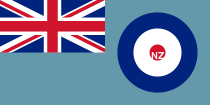 |
|
| Name | Ensign of the Royal New Zealand Air Force |
| Proportion | 1:2 |
| Design | A field of air force blue with the Union Flag in the canton and the Royal Air Force roundel defaced with the letters "NZ" in the fly |
The flag of New Zealand is a defaced Blue Ensign with the Union Flag in the canton, and four red stars with white borders to the right. The stars represent the constellation of Crux, the Southern Cross, as seen from New Zealand. New Zealand's first flag was adopted before it became a British colony. Chosen by an assembly of Maori chiefs in 1834, the flag was of a St. George's Cross with another cross in the canton containing 4 stars on a blue field. After the formation of the colony in 1841, British ensigns began to be used. The current flag was designed and adopted for restricted use in 1869 and became the national flag in 1902. It is the British Ensign, with a highly stylized representation of the Southern Cross constellation. It depicts only 4 of the 5 stars in the constellation. Each star varies slightly in size. The Union Jack in the canton recalls New Zealand's colonial ties to Britain.
The flag proportion is 1:2 and the colours are Red (Pantone 186), Royal Blue[1] (Pantone 293) and White. Proportion and colours are identical to the Union Flag.
Contents |
History
Flag of the United Tribes
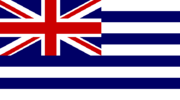


The need for a flag of New Zealand first became clear when the trading ship Sir George Murray, built in the Hokianga, was seized by Customs officials in the port of Sydney. The ship had been sailing without a flag, a violation of British navigation laws. New Zealand-built ships could not fly under a British flag due to New Zealand's colonial status. Among the passengers on the ship were two high-ranking Māori chiefs, believed to be Patuone and Taonui. The ship's detainment was reported as arousing indignation among the Māori population. Unless a flag was selected, ships would continue to be seized.[2]
The first flag of New Zealand was adopted on 9 March 1834 by a vote made by the United Tribes of New Zealand, a meeting of Māori chiefs, who later made the Declaration of Independence of New Zealand, at Waitangi in 1835. Three flags were proposed, all purportedly designed by the missionary Henry Williams, who was to play a major role in the translation of the Treaty of Waitangi in 1840. The Chiefs rejected two other proposals which included the Union Flag, in favour of a modified St George's Cross or the White Ensign. This flag became known as the flag of the United Tribes of New Zealand. The need for a flag was pressing, not only because New Zealand-built ships were being impounded in Sydney for not flying a national flag, but also as a symbol of the independence declared by the Māori chiefs.
The flag is still flown on the flag pole at Waitangi, and can be seen on Waitangi Day.
Union Flag
After the signing of the Treaty of Waitangi, the British Union Flag was used, although the former United Tribes flag was still used by a number of ships from New Zealand and in many cases on land. The New Zealand Company settlement at Wellington, for example, continued to use the United Tribes flag until ordered to replace it by Governor William Hobson in 1841.
Flags based on defaced Blue ensign
The first flag of New Zealand to be based on the British blue ensign was introduced in 1867 following the Colonial Navy Defence Act 1865, which required all ships owned by colonial governments fly the defaced Royal Navy blue ensign with a Colonial badge. New Zealand did not have a Colonial badge, or indeed a Coat of Arms of its own at this stage, and so the letters "NZ" were simply added to the blue ensign.
The current flag was introduced in 1869. It was initially used only on government ships, but was adopted as the de facto national flag in a surge of patriotism arising from the Second Boer War in 1902. To end confusion between various designs of the flag, the Liberal Government passed the Ensign and Code Signals Bill, which was approved by King Edward VII on 24 March 1902, declaring the flag as New Zealand's national flag. The United Tribes flag design also features on the back of the Second Boer War medals presented to soldiers who served in the war,[3] which indicates that the United Tribes flag was used widely in New Zealand until around this time.
Legislation
The national flag is officially defined in the Flags, Emblems, and Names Protection Act 1981. Section 5(2) declares it to be "the symbol of the Realm, Government, and people of New Zealand."[4]
Entrenchment proposal
In March 1994 the then Prime Minister of New Zealand Jim Bolger made statements supporting a move towards a New Zealand republic.[5] In response Christian Democrat MP Graeme Lee introduced a Flags, Anthems, Emblems, and Names Protection Amendment Bill.[6] If passed, the Bill would have entrenched the Act that governs the flag and added New Zealand's anthems, requiring a majority of 65 percent of votes in Parliament before any future legislation could change the flag. The Bill passed its first reading but was defeated at its second reading, 26 votes to 37.
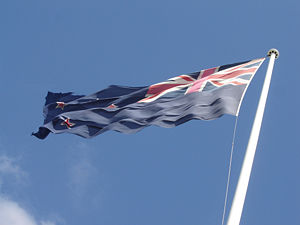
Flag debate
For several years a number of people have been proposing designs for an alternative flag for New Zealand. In November 1979 the Minister of Internal Affairs, Allan Highet suggested that the design of the flag should be changed, and sought an artist to design a new flag with a silver fern on the fly. The proposal attracted little support however.[7] In 1998 National Prime Minister Jenny Shipley backed Cultural Affairs Minister Marie Hasler's call for the flag to be changed. Shipley, along with the New Zealand Tourism Board, backed the quasi-national Silver fern flag, using a white Silver Fern on a black background as a possible alternative flag, along the lines of the Canadian Maple Leaf Flag.
In 2003, the NZ Flag.com Trust was founded with the aim of bringing about a non-binding referendum on the subject. Under New Zealand law, a referendum may be held on any issue if 10% of electors sign a petition which is presented to Parliament. The Trust launched their petition for such a referendum in 2005.
In response to the petition, the New Zealand Flag Institute was founded to oppose the referendum campaign and promote the current flag, as well as to offer a more scholarly view of the Flag. Surprisingly, the Royal New Zealand Returned Services' Association (the RSA), the New Zealand organisation for war veterans, did not openly back the current flag at its annual conference, calling instead for "...politics to be kept out of the debate". This attitude was however criticised by individual branches of the RSA, who support the current flag.
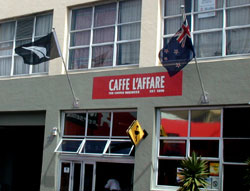
The petition failed to attract enough signatures (around 100,000 people signed the petition) in time for the 2005 general election in September and was withdrawn in July. The NZ Flag.com Trust cited public apathy to change as the main reason for withdrawing the petition. The New Zealand Flag Institute ascribed the failure of the campaign to public support for the New Zealand Flag.
Arguments for change
Proponents for change argue that the current flag:
- Is very similar to and is sometimes confused with the Australian flag;
- As a defaced Blue Ensign, it alludes to New Zealand being a colony or sub-part of the United Kingdom;
- Ignores New Zealand's Māori heritage and other ethnic groups;
- Does not evoke emotional feelings and is rarely flown by New Zealanders;
- Has little connection with the land;
- Has many designs and colour schemes;
- New Zealand organisation for war veterans do not openly back the current flag;
- Has in recent years been appropriated by nationalist groups such as the New Zealand National Front.[8][9]
Arguments against change
Opponents to change argue that the current flag:
- Was chosen by New Zealanders;
- Does evoke emotional response in them;
- Represents the history of the country as a part of the British Empire and location in the southern hemisphere;
- Is a colourful design;
- No one flag challenging the current one;
- Is the flag New Zealanders have fought and died for, and changing it would be greatly offensive to New Zealand's war veterans;
- Has represented the country for over a century.
Some also claim that it is not as similar to the Australian flag as is often suggested, and that many countries have flags that are very similar — or even identical — to the flags of other countries. They also criticise the proposed alternatives, saying they focus on Māori and Pacific designs when most of New Zealand's heritage is Anglo-Saxon and Celtic, or the Silver Fern which they say is the logo of some of New Zealand's sporting teams rather than the country itself. In response, supporters of the Silver fern point out that the leaf itself has been used as a symbol of New Zealand since at least the Boer war (when it featured on military insignia[10]) and is already a national emblem, being used for various official symbols, including the Coat of arms of New Zealand and the New Zealand One Dollar coin.
Currently opinion polls indicate a majority in favour of retaining the present flag. There is no consensus among proponents of changing the flag as to which design should replace the flag, though this is not to say that there have been no well-known proposals for an alternative.
The flag debate has been separate from the New Zealand republican debate - the Republican Movement of Aotearoa New Zealand states that "creating a republic does not require any change to the Treaty of Waitangi, flag or Commonwealth membership",[11] while NZFlag has stated that changing the flag "is not anti-royalist in any way".[12]
However opinions as to the ideal alternative are varied, and proponents of changing the flag suggest they would rather leave the final decision on the future flag up to the New Zealand public.
Proposed alternative designs

A flag with a long history as an alternative New Zealand flag is Friedensreich Hundertwasser's Koru Flag, designed in 1983. This flag represents an uncurling fern frond in a stylised form of a traditional Māori carving pattern, the koru. This flag, which is occasionally seen around the country, has a degree of support, especially among alternative lifestylers and similar more liberal groups.

A popular alternative to the current defaced Blue Ensign was designed by Kyle Lockwood (left). It won a Wellington newspaper flag competition in July 2004 and appeared on TV One in 2005 after winning a poll which included the present national flag. The fern represents the people of New Zealand and the stars represent the location of New Zealand. The blue colour represents the ocean, the red represents the Māori and also sacrifices during wartime, and white is a reference to the "Land of the Long White Cloud" (translated from the Māori "Aotearoa").
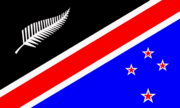
An earlier (2001) design which also gained a great deal of media publicity was that by James Dignan. This design was produced in newspapers around the country in 2002, at the time of the centenary of the current flag, and may have (at least unconsciously) been a trigger for Lockwood's design. This combines the red, white, and blue and Southern Cross of the current national flag (albeit a lighter blue) with the red, white, and black of the flag of Tino rangatiratanga, also incorporating the silver fern on black used to represent New Zealand in many overseas contexts. This combination both looked back to traditional links with the United Kingdom and also forward to New Zealand's current place as a Polynesian cultural centre.


Many members of the public have taken to putting forward their own proposals for a flag change. For example designers who seek to retain visible links with New Zealand's British heritage have attempted 'honourable compromises' which incorporate the Union Jack to some extent. The Blue Union Jack flag proposal incorporates a red koru growing out of a semblance of a Union Jack which represents growth out of British and Māori heritage and a southern cross. The blue symbolises the Pacific ocean and red symbolises Maoridom. The white band represents the 'long white cloud'. Black and white have over time become New Zealand's national colours.
Other flags



There is also a New Zealand red ensign which became the official flag for merchant vessels in 1901.[13] Previously a plain red ensign was used.
The red ensign may continue to be flown on land in Māori areas or during Māori events under the Flags, Emblems, and Names Protection Act 1981 in recognition of long held Māori preference for red flags. New Zealand law allows the defacement of the flag in accordance to Māori custom in which white capital letters identifying a particular family or Māori tribe are added. In the case of the flag on the left, TAKITIMU refers to a grouping of Māori tribes descended from the crew of the ancestral canoe of that name.[14]
This flag also serves as a guide to one concept for flags representing both the North and South Islands (see List of flags - Flags of New Zealand).
Today, private and merchant craft can choose to fly the Flag of New Zealand (i.e., the blue ensign) or the Southern Cross red ensign.
The New Zealand flag is also used as a jack[15] by warships.
Since 1990, some Māori have been using the red ensign less in favour of a new flag which lacks colonial connotations. Chosen through a competition, the Māori flag uses black to represent Korekore or potentiality, white to represent the Ao marama or the physical world of light and understanding, red to represent whaiao or open daylight (representing the achievement of full potential and understanding), and the Koru, a spiral-like shape representing the unfolding of new life. The flag is generally called the Tino rangatiratanga flag.
The Māori flags Te Paerangi and Te Paekinga of the Māori King Movement, and Te Kooti's more elaborate battle flag all carried a 'triple star' which some have suggested represented the three main islands of Aotearoa or Tane's three baskets of knowledge. One of New Zealand's two national anthems, 'God Defend New Zealand', includes the line 'Guard Pacific's triple star' and there has been various speculation over the years as to whether this was a reference to the three islands, or perhaps to the Māori battle flag - the anthem's author, Thomas Bracken, being something of an Irish anti-colonial.
See also
- New Zealand Flag Institute
- Australian flag debate
- Canadian Flag Debate
- List of New Zealand flags
- Flag of the Chatham Islands
References
- ↑ Ministry of Heritage and Culture, Introduction, http://www.mch.govt.nz/nzflag/index.html, "Its royal blue background is reminiscent of the blue sea and clear sky surrounding us". Retrieved 2008 08 06.
- ↑ History of the New Zealand Flag: Flag of the United Tribes of New Zealand (1834-1840). Ministry for Culture and Heritage. Retrieved 2007-02-16
- ↑ Digger History: Medals of New Zealand
- ↑ http://www.legislation.govt.nz/libraries/contents/om_isapi.dll?clientID=67982&hitsperheading=on&infobase=pal_statutes.nfo&jump=a1981-047%2fs.5&softpage=DOC#JUMPDEST_a1981-047/s.5
- ↑ "History of Republicanism in New Zealand - 1994". Republican Movement of Aotearoa New Zealand (November 2007). Retrieved on 2007-11-27.
- ↑ "Maori Law Review - New Zeeland". Maori Law Review (September 1994).
- ↑ "New Zealand - Proposals for a new flag". Flags of the World (29 September 2006). Retrieved on 2007-09-01.
- ↑ Fight dem back!
- ↑ NF Speech
- ↑ Digger History: Badges of New Zealand
- ↑ Republican Movement of Aotearoa New Zealand
- ↑ New Zealand Flag Change Not Anti-Royalist
- ↑ New Zealand Ensigns
- ↑ New Zealand - Maori Flags
- ↑ Barraclough, E. M. C.; Crampton, W.G.. Flags of the World. London: Frederick Warne. pp. 211. ISBN 0-7232-2015-8. "The Naval Ensign, like that of Australia, was only recently adopted, New Zealand having previously used the British White Ensign, and the National Flag as a Jack…[Image of the flag, then a caption:] New Zealand: National Flag and Jack".
External links
- Ministry of Culture and Heritage - New Zealand Flag
- Maritime history of the flag
- NZ Flag.com Official website
- New Zealand and the Māori flag
- Other New Zealand flags From Flags of the World
- Proposals for a new flag Jason Troup Proposal Kyle Lockwood Proposal
- Proposals for "new" NZ Flag. JOHN HYNDMAN'S BLOG [1]
- Proposed Long white cloud flag
|
|||||||||||
|
|||||||||||||||||